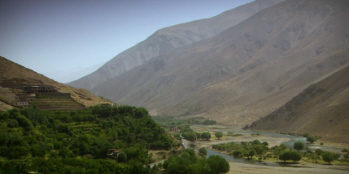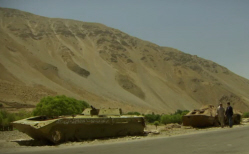General Muslim
The Fight In the Panjshir Valley
Weapons
Now, the Soviets faced not just the popular resistance, but a guerrilla army equipped with the latest in military hardware. And when America
started supplying Stinger later and other anti-aircraft missiles to the Mujahideen, they started bringing down Soviet helicopters.
But it was the mines, or what we would call today IED’s, that the Soviets remember. And Afghans had become the specialists in mines they
still are today.
General Muslim lead the Afghan resistance in this part of the Panjshir Valley.
General Muslim “This area has witnessed many years of fighting between 1981 and 1987. And our job was to plant the mines during the night
covering the few kilometres long road from Bazarak to Astana.”

Panjshir Valley
General Muslim

Russian Tank Debris
And this is the only way to cross the area?
General Muslim “Yes this is the only way through, and this helps when it comes to fighting. We always had these mountains covered and you
see that white stone over there? That was our observation point, which is about 600 m from here. So when the enemies would attack, we would
get ourselves in there, close to the road.”
The bulk of Soviet supplies came by roads like these and the Mujahideen attacks began to kill thousands of Soviet soldiers and cut off
their supply routes. The Russians began to call this conflict a war of mines.
General Muslim “We would always plant the mine in the middle of the road and its switch would be on the side of the road, that way its
destructive power was maximised. Since this was a very good place for ambush we had very little casualties while enemies would endure heavy
losses. Most of the tanks that you see here, the stronger ones, were hit by mines. And their trip-carrying trucks have been destroyed by
rockets or hand grenades thrown under the trucks. More than about 100 tanks and 400 trucks carrying their weaponries have been destroyed.
I think their are number of deaths would have exceeded 1000. “
The Soviet army brought in helicopters, experimented with new tactics, took the most brutal revenge against villages, but they were
never able to defeat the insurgents.
Russian Helicopter
The Russian Special Forces that landed from helicopters on these ridgelines were some of the toughest most courageous, best trained
troops in the world. And yet, they never really saw their enemy. They were attacked with mines, people shot into their tents at night,
they were suddenly ambushed with rockets. And when they wanted to put all their military training, all their courage, all their energy
into action, they felt they were fighting an army of ghosts.
And so, if the Soviet tactics hadn’t worked, weren’t working, and weren’t going to work, why did they continue? A British ambassador
once said to me that the US and its allies could not leave Afghanistan because they had lost too much blood and treasure. And the same
thought has been in the minds of people for centuries here.
Because when empires begin to lose, begin to spend, begin to have soldiers killed, begin to make promises, begin to produce
justifications, it becomes more and more difficult for them to leave. And they end up simply piling more corpses on top of their
soldier’s bodies in the hope that this can somehow justify their loss.
In very blunt terms, those soldiers are dead and gone, and they’re never coming back, and you can never honour soldiers by by
piling more corpses on top of their head. but no general feels this, no politician can say this, and slowly killing
and the occupation continues far longer than it ever should.
At home, the Soviets tried to conceal the failures and brutality of this occupation. The public was told the Soviets were popular,
were helping the Afghan people and that the rebels were only a small minority of terrorists.

